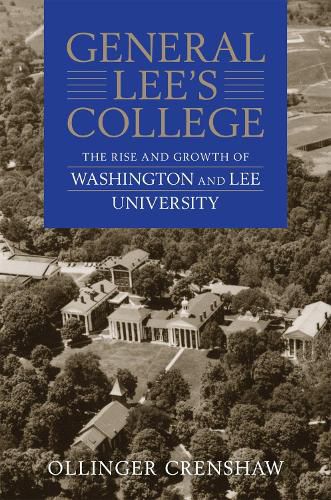Readings Newsletter
Become a Readings Member to make your shopping experience even easier.
Sign in or sign up for free!
You’re not far away from qualifying for FREE standard shipping within Australia
You’ve qualified for FREE standard shipping within Australia
The cart is loading…






Originally published in 1969 and now available in this new edition, General Lee’s College offers the early history of the institution that became Washington and Lee University. Emerging from obscure eighteenth- century origins on the Virginia frontier as Liberty Hall Academy, it struggled for survival against what at times appeared to be overwhelming odds. Receiving a sizeable gift from Virginia native George Washington in 1796, the school soon after assumed the name Washington College and established itself in the mold of the classical colleges of the Old South, as faculty and administrators promoted a provincial outlook and strict adherence to Presbyterian teachings. Secession and civil war had a dramatic impact on the college, as military service called away students, most of whom enlisted with the Confederate army. The Union victory in 1865 prompted college trustees to lay out a new vision for the institution, and they elected Confederate general Robert E. Lee, another native son of Virginia, to lead the college as president through the uncertainty of the postwar years.
After Lee’s death in 1870, the school’s fortunes ebbed and flowed against the backdrop of Reconstruction. Yet the institution- renamed Washington and Lee University- rebounded in the decades after World War I. With an expanded curriculum, a larger faculty, and a more diverse student body, the school began to blaze a path of success that stretches well into the twenty-first century.
$9.00 standard shipping within Australia
FREE standard shipping within Australia for orders over $100.00
Express & International shipping calculated at checkout
Originally published in 1969 and now available in this new edition, General Lee’s College offers the early history of the institution that became Washington and Lee University. Emerging from obscure eighteenth- century origins on the Virginia frontier as Liberty Hall Academy, it struggled for survival against what at times appeared to be overwhelming odds. Receiving a sizeable gift from Virginia native George Washington in 1796, the school soon after assumed the name Washington College and established itself in the mold of the classical colleges of the Old South, as faculty and administrators promoted a provincial outlook and strict adherence to Presbyterian teachings. Secession and civil war had a dramatic impact on the college, as military service called away students, most of whom enlisted with the Confederate army. The Union victory in 1865 prompted college trustees to lay out a new vision for the institution, and they elected Confederate general Robert E. Lee, another native son of Virginia, to lead the college as president through the uncertainty of the postwar years.
After Lee’s death in 1870, the school’s fortunes ebbed and flowed against the backdrop of Reconstruction. Yet the institution- renamed Washington and Lee University- rebounded in the decades after World War I. With an expanded curriculum, a larger faculty, and a more diverse student body, the school began to blaze a path of success that stretches well into the twenty-first century.